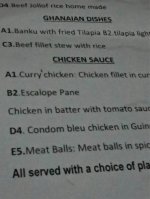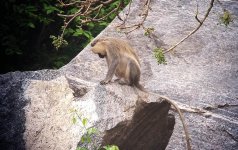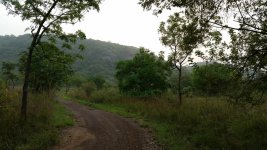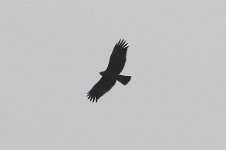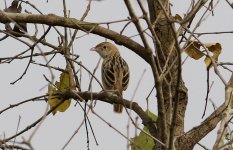tittletattler
Well-known member
Hi all,
If anyone is looking to plan a trip early in the New Year, I would thoroughly recommend an Ashanti lead tour in Ghana. Ashanti also help all or nearly all the big tour companies. Their guides, especially James Ntakor, are exceptional :t:
I'll post the trip details and some photos over the Xmas period. For starters, here are some basic details about the accommodation used, itinerary etc.
Flights and travel.
We paid £417 each for our return flights with KLM which included an hour’s flight to Schiphol from Heathrow and then a seven hour flight to Accra. The return flight from Schiphol took us to London City Airport.
We each paid Ashanti African Tours £2,200 for all services including travel, entrance fees to National Parks, food and bottled water as well as all accommodation.
The two of us were driven around Ghana in a sturdy air-conditioned Toyota 4x4 which was very comfortable. At Ankasa, Ashanti provided a Landrover for driving along the forest track. This was especially necessary for navigating around fallen trees. We were accompanied by our guide, James Ntakor, and our driver Jo Jo. Both were exceptional and I doubt that there could be a better guide in Ghana than James.
Accommodation.
All of the accommodation had, at the very least, clean, insect proof bedrooms with a ceiling fan and an en-suite bathroom. Bobiri didn’t have a ceiling fan and the ceiling fan at Frenchman’s guesthouse in Ankasa was dangerous but both sites had portable fans too. Note that Ashanti are building accommodation at Ankasa.
Normal Ashanti organised tours with the major bird tour companies will provide much better accommodation with air-conditioning, wi-fi etc but this will cost roughly five times as much per night so $50 dollars per room rather than $10 and will require a drive to the forest/reserve each morning of up to thirty minutes. The advantage of staying in the forest in the more basic accommodation is that you don’t have to travel so you get up in the morning and can walk straight into some of the reserves. This is also better for night birds and mammals. I benefitted hugely at Kakum, Ankasa and Bobiri by being able to plug my 20w Wemlite bulb into the mains sockets handily situated on the outside of the accommodation and the moths attracted as a result were amazing.
The rooms by the gate entrance at Kakum don’t seem to be advertised on line and the same seems to be true of the accommodation inside Bobiri. As such, if you did this trip independently, you might still need to use Ashanti as ground agents in order to book this accommodation.
As my companion doesn’t like to share a room, it cost us more to have a room each at all sites so this increased the total cost considerably even though it was a budget trip. My companion also struggled with the heat and Ashanti very kindly upgraded our accommodation free of charge on two occasions so that he could benefit from having an air-conditioned room. Upon reflection, this is probably the ideal way to do the trip. With proper planning, I would recommend booking a budget trip with Ashanti for 4-6 people, staying in the budget accommodation at each site but also having a couple of stays in air-conditioned hotels at appropriate points during the trip. This should cost considerably less than booking via one of the major tour companies.
Money.
About five Ghanain cedis to the Pound. I changed up £100 at the kiosk just inside the airport exit upon arrival. I spent just £40 on beer and soft drinks in the entire two weeks.
Food & Drink
Breakfast, lunch & dinner were included in the tour price but note that restaurant meals cost about £5, more or less. ‘Red Red’ with rice was good but I found that Chicken sauce and rice to be ideal as it varied between being a curry to being a pasta sauce to being a Spanish sauce which meant it was different (and very tasty) everywhere. I didn’t try the ‘condom’ chicken at the first guest house. Beer costs about five cedis for 600ml bottles (‘Club’ was my favourite) and soft drinks were between 2.5 cedis and 5 cedis.
Itinerary
18th Feb – London to Amsterdam and then on to Accra.
19th Feb – Shai Hills & Wineba Plains
20th Feb – Kakum NP
21st Feb – Antikwa, Kakum area
22nd Feb – Abrufo Road & Forest, Kakum area
23rd Feb - International Stingless Bees Centre (!), Kakum & Nsuta Forest
24th Feb – Nsuta Forest
25th Feb – Ankasa
26th Feb – Ankasa
27th Feb – Ankasa & Cape Coast
28th Feb – Abrufo & Picathartes
1st Mar – Bobiri
2nd Mar – Offinso
3rd Mar – Atewa farm/bush
4th Mar – Atewa ridge
5th Mar – farm/bush nr Atewa
If anyone is looking to plan a trip early in the New Year, I would thoroughly recommend an Ashanti lead tour in Ghana. Ashanti also help all or nearly all the big tour companies. Their guides, especially James Ntakor, are exceptional :t:
I'll post the trip details and some photos over the Xmas period. For starters, here are some basic details about the accommodation used, itinerary etc.
Flights and travel.
We paid £417 each for our return flights with KLM which included an hour’s flight to Schiphol from Heathrow and then a seven hour flight to Accra. The return flight from Schiphol took us to London City Airport.
We each paid Ashanti African Tours £2,200 for all services including travel, entrance fees to National Parks, food and bottled water as well as all accommodation.
The two of us were driven around Ghana in a sturdy air-conditioned Toyota 4x4 which was very comfortable. At Ankasa, Ashanti provided a Landrover for driving along the forest track. This was especially necessary for navigating around fallen trees. We were accompanied by our guide, James Ntakor, and our driver Jo Jo. Both were exceptional and I doubt that there could be a better guide in Ghana than James.
Accommodation.
All of the accommodation had, at the very least, clean, insect proof bedrooms with a ceiling fan and an en-suite bathroom. Bobiri didn’t have a ceiling fan and the ceiling fan at Frenchman’s guesthouse in Ankasa was dangerous but both sites had portable fans too. Note that Ashanti are building accommodation at Ankasa.
Normal Ashanti organised tours with the major bird tour companies will provide much better accommodation with air-conditioning, wi-fi etc but this will cost roughly five times as much per night so $50 dollars per room rather than $10 and will require a drive to the forest/reserve each morning of up to thirty minutes. The advantage of staying in the forest in the more basic accommodation is that you don’t have to travel so you get up in the morning and can walk straight into some of the reserves. This is also better for night birds and mammals. I benefitted hugely at Kakum, Ankasa and Bobiri by being able to plug my 20w Wemlite bulb into the mains sockets handily situated on the outside of the accommodation and the moths attracted as a result were amazing.
The rooms by the gate entrance at Kakum don’t seem to be advertised on line and the same seems to be true of the accommodation inside Bobiri. As such, if you did this trip independently, you might still need to use Ashanti as ground agents in order to book this accommodation.
As my companion doesn’t like to share a room, it cost us more to have a room each at all sites so this increased the total cost considerably even though it was a budget trip. My companion also struggled with the heat and Ashanti very kindly upgraded our accommodation free of charge on two occasions so that he could benefit from having an air-conditioned room. Upon reflection, this is probably the ideal way to do the trip. With proper planning, I would recommend booking a budget trip with Ashanti for 4-6 people, staying in the budget accommodation at each site but also having a couple of stays in air-conditioned hotels at appropriate points during the trip. This should cost considerably less than booking via one of the major tour companies.
Money.
About five Ghanain cedis to the Pound. I changed up £100 at the kiosk just inside the airport exit upon arrival. I spent just £40 on beer and soft drinks in the entire two weeks.
Food & Drink
Breakfast, lunch & dinner were included in the tour price but note that restaurant meals cost about £5, more or less. ‘Red Red’ with rice was good but I found that Chicken sauce and rice to be ideal as it varied between being a curry to being a pasta sauce to being a Spanish sauce which meant it was different (and very tasty) everywhere. I didn’t try the ‘condom’ chicken at the first guest house. Beer costs about five cedis for 600ml bottles (‘Club’ was my favourite) and soft drinks were between 2.5 cedis and 5 cedis.
Itinerary
18th Feb – London to Amsterdam and then on to Accra.
19th Feb – Shai Hills & Wineba Plains
20th Feb – Kakum NP
21st Feb – Antikwa, Kakum area
22nd Feb – Abrufo Road & Forest, Kakum area
23rd Feb - International Stingless Bees Centre (!), Kakum & Nsuta Forest
24th Feb – Nsuta Forest
25th Feb – Ankasa
26th Feb – Ankasa
27th Feb – Ankasa & Cape Coast
28th Feb – Abrufo & Picathartes
1st Mar – Bobiri
2nd Mar – Offinso
3rd Mar – Atewa farm/bush
4th Mar – Atewa ridge
5th Mar – farm/bush nr Atewa
Last edited:





